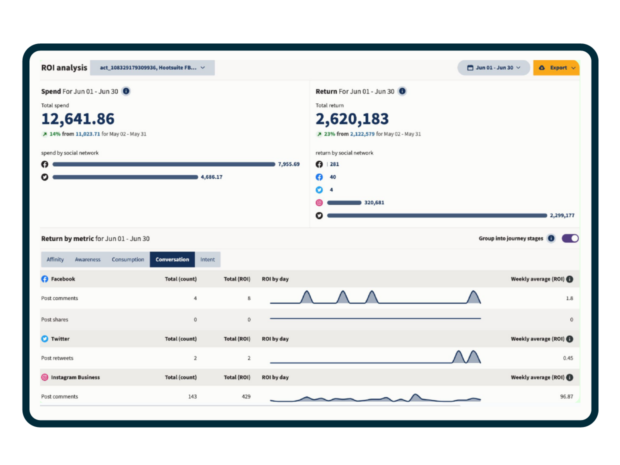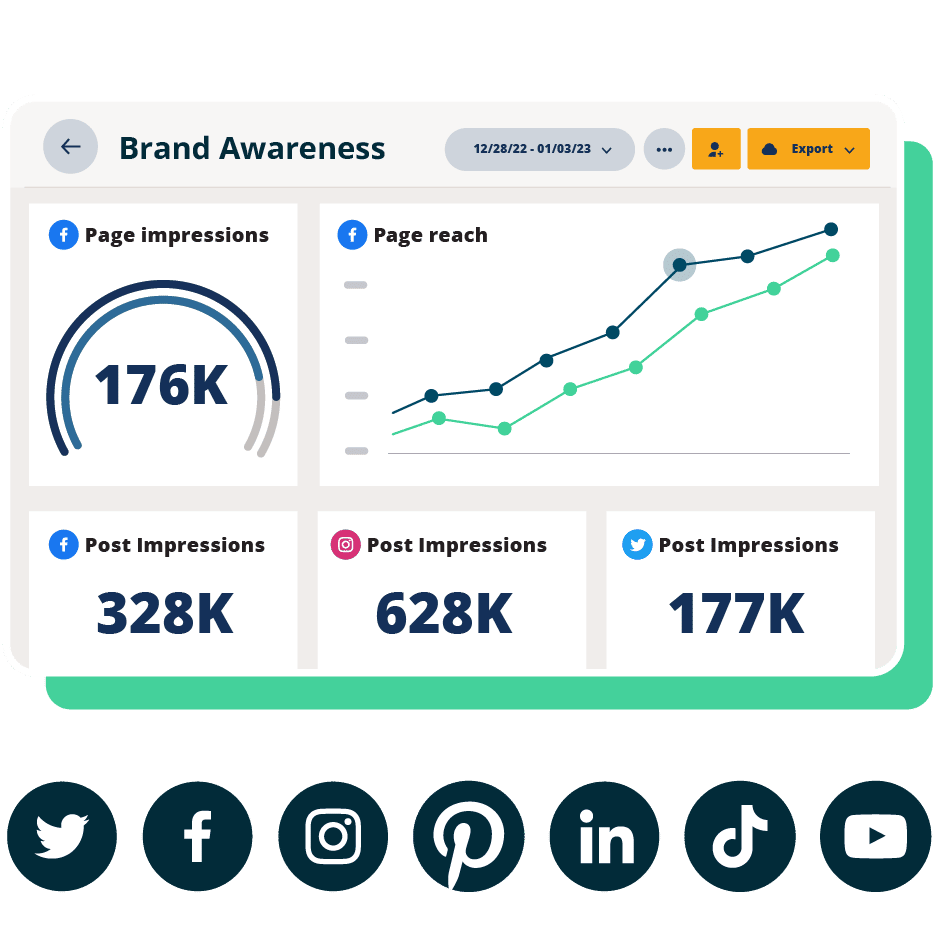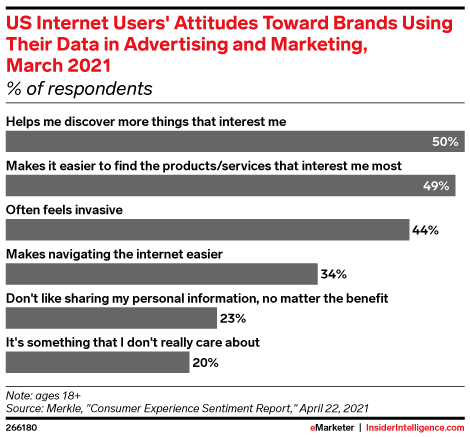One of social media’s greatest advantages for marketers is the ability to gather data in real-time. Social media data can help you gauge the initial success of a campaign within just a couple of hours of your launch. Over time, it provides more detailed insights about your business and your industry, so you can make the most of the time and resources you invest in social marketing.
Social media data mining also gives you key insights into your audience. You can learn what kind of content they like, when they want to see it, and where they spend their time online.
Social media data is any type of data that can be gathered through social media. In general, the term refers to social media metrics and demographics collected through analytics tools on social platforms.
Social media data can also refer to data collected from content people post publicly on social media. This type of social media data for marketing can be collected through social listening tools.
Like any business strategy, social media marketing is most effective when your goals and plans are based on real data.
Social media data analytics provide information that helps you understand what’s working. Even more important, you’ll see what’s not working, so you can make the right business decisions and refine your strategy as you move forward.
Social media data collection can help you customize your social media marketing strategy for each social network. Even more specifically, you can customize your strategy by location or demographics.
Here are some of the questions social media data mining can help answer:
- What is the demographic profile of your following on each social platform?
- What times of day is your audience most active on social media?
- Which hashtags is your audience most likely to engage with?
- Does your audience prefer images or video posts?
- What kinds of content is your audience interested in?
- What subjects does your audience need help with?
- Which top-performing organic posts should you pay to boost?
You can also use social media to conduct A/B testing. This helps you refine your marketing message element by element so you can increase your ROI.
Finally, social media data helps you prove the value of your social media efforts. With a proper data collection in place, you can tie social media to real business results like sales, subscriptions, and brand awareness.
Which social media data you want to track will depend on your business goals.
If you want to use social media to build brand awareness, you might be most interested in tracking engagement. If your goal is to create sales, you’ll likely want to track conversions.
Here is some of the most important raw data you can collect through social media:
- Engagement: Clicks, comments, shares, etc.
- Reach
- Impressions and video views
- Follower count and growth over time
- Profile visits
- Brand sentiment
- Social share of voice
- Demographic data: age, gender, location, language, behaviors, etc.
The first step to developing an effective social media data analysis plan is to establish SMART goals. Next is to decide which data points you will track to measure progress towards your goals.
Here’s a rundown of how your goals, your social media data, and analytics all come together to form your social media strategy:
So, where can you get your hands on this data? Most social platforms have built-in analytics. These provide basic data about your account performance and audience demographics.
But to get the most out of your social media data, it’s important to get a unified view. Here’s how to make that happen.
Gather data with a social media data analytics tool
A social media analytics tool like Hootsuite Analytics gives you a full view of your social media data across platforms. This provides important context for your data, as you can see how your audience responds on different channels and refine your platform-specific strategy.
For larger social media marketing teams with more in-depth data analysis needs, Hootsuite Advanced Analytics directly tracks social media data to business goals and provides helpful competitive benchmarks.

For more options, check out our full post on social media data analytics tools.
Record your findings
Social media data collection efforts can be overwhelming if you don’t have a system for recording all the information.
We’ve created a free social media data analysis template to track your data in an Excel spreadsheet or Google Sheet. It allows you to record your social media data for multiple platforms and compare the results to your target goals.
Share the results in a social media report
To use your social media data for marketing planning and analysis, you need to compile the data into an easy-to-digest format that key stakeholders can understand.
Analytics programs like Hootsuite Analytics will create custom reports for you. Prefer to create your social media report manually? We’ve got a free social report template you can use to create a professional presentation of your social media data.
Beautiful reports. Clear data. Actionable insights to help you grow faster.
1. Know your goals and KPIs
As we mentioned above, social media data is most useful when looked at in the context of real business goals and key performance indicators (KPIs). When you have goals in place, you can use social media data to track your progress and look for areas where you might need to improve.
But without goals in place, your social data lacks context. Sure, you’ll be able to see whether individual data points are moving in a positive or negative direction. But you won’t be able to understand the big picture.
Not sure where to start with goal-setting? We’ve got nine sample goals to get you started.
2. Track platform-specific social data
We’ve said social media data can give you a great unified view of your cross-platform social strategy. It can also help you get really granular about your strategy for each social platform.
For example, you’ll start to see trends that guide you towards the best times to post on each of your social accounts. (Hootsuite can help on this front with automated best-time-to-post suggestions based on your own social media data.)
You’ll also start to understand your followers on each social media channel, which can help you build buyer personas to better target your audience.
3. Set up a social listening program
Social listening can provide another set of social media data for you to draw from. The data we’ve talked about so far comes in through your owned social properties. Social listening can help you discover data from social media users who have no existing relationship with your brand.
It can also help put your social media data in context within your industry.
For example, social listening can provide data like:
- How many people are talking about your business or your products online (whether or not they tag you in their posts)
- How many people are talking about your competitors
- What kinds of interests and concerns people express when talking about your industry on social media
- How people feel about your latest product launch (a.k.a. sentiment analysis)
- Whether your competitors are running any promotions or launches you need to address
You can also get creative with your social listening strategies. Think about ways people’s social media posts could help provide useful data for your business.
For example, researchers found they could use text social media data mining to predict morning traffic patterns or gain insights into college students’ mental health. For businesses, social media data mining can help predict demand and improve supply chain performance.
In one specific example, a study on social media data in Ottawa, Canada, found that social listening data could be used to identify the attributes local residents find most important when recommending where to buy fresh produce. This information could help guide local produce and grocery stores’ marketing messages, or even store design.
Social listening provides valuable social data about existing communities online. According to the Hootsuite Social Trends 2022 report:
“The smartest brands in 2022 will tap into existing creator communities to learn more about their customers, simplify content creation, and build brand awareness and affinity.”
The same report found 48% of marketers strongly agree social listening has increased in value for their organization.
4. Ensure you comply with the rules
Data security on social media is not something to take lightly. More than a third of Internet users worldwide (33.1%) have concerns about misuse of their personal data online.
If you work in a regulated industry, there are specific data privacy and compliance concerns you need to manage. But privacy and data security are issues all social media managers should keep in mind.
For example, the Facebook Pixel is a useful tool for collecting social media data. It tracks conversions and how people behave once they click through to your website. It uses cookies, so if you implement this tool, you need to include a disclosure on your website telling people how you use cookies and share data collected through them.
Privacy and data security requirements vary by region. Talk to your compliance or legal team about any specific concerns, and be sure to review the terms of service for each social platform.
5. Focus on personalization (but not too much)
Social media data allows you to personalize social ads with strategies like remarketing or demographics segmentation. But be careful not to go too far.
Half of U.S. internet users said brands using personal data in advertising helps them discover things they’re interested in. And 49% said it makes it easier to find the products and services that most interest them. But 44% said this can feel invasive.

Likewise, Gartner found social messages that incorporate too many social data points can be perceived as “creepy.” They found the best way to use social data for personalization is to create messages tailored to be helpful based on up to three customer data dimensions.
For instance, I regularly see ads in my Instagram feed for vegan food delivery services in Vancouver. Those are well-targeted ads based on a couple of data points (location and behaviors). However, I also occasionally see click-bait personalized headlines like, “Women in Vancouver born before 19XX need to know about this!” That, my friends, is creepy.
How do you find the right balance? As the Gartner report suggests, people are much more receptive to their data being used to benefit them (the user) rather than the marketer. Help the potential customer in genuine ways to get the greatest benefit from social media data without scaring them away.
Track social media data and refine your strategy with Hootsuite. Publish your posts and analyze the results in the same, easy-to-use dashboard. Try it free today.







